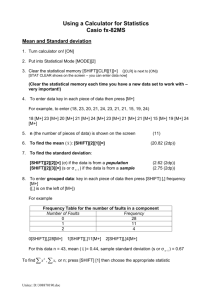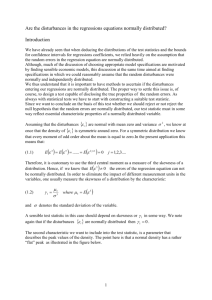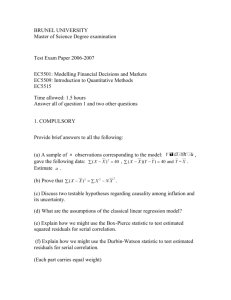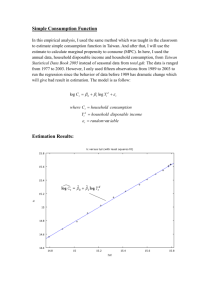glm_nonlin_probs
advertisement
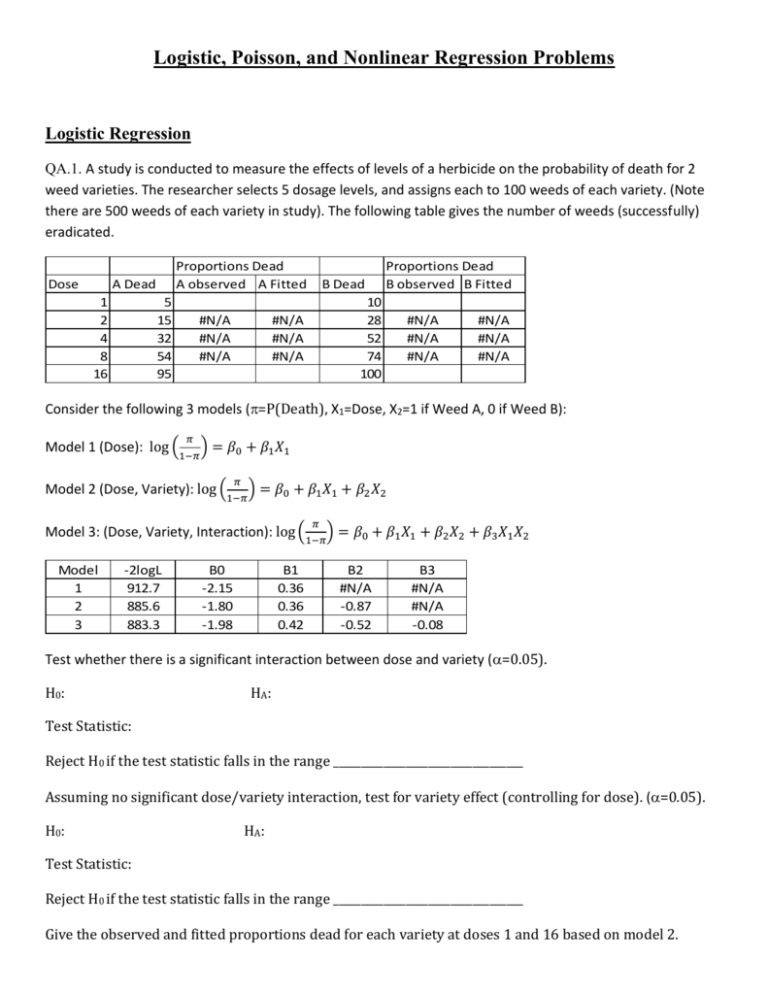
Logistic, Poisson, and Nonlinear Regression Problems
Logistic Regression
QA.1. A study is conducted to measure the effects of levels of a herbicide on the probability of death for 2
weed varieties. The researcher selects 5 dosage levels, and assigns each to 100 weeds of each variety. (Note
there are 500 weeds of each variety in study). The following table gives the number of weeds (successfully)
eradicated.
Dose
Proportions Dead
A observed A Fitted
A Dead
1
2
4
8
16
5
15
32
54
95
#N/A
#N/A
#N/A
B Dead
Proportions Dead
B observed B Fitted
10
28
52
74
100
#N/A
#N/A
#N/A
#N/A
#N/A
#N/A
#N/A
#N/A
#N/A
Consider the following 3 models (=P(Death), X1=Dose, X2=1 if Weed A, 0 if Weed B):
𝜋
Model 1 (Dose): log (1−𝜋) = 𝛽0 + 𝛽1 𝑋1
𝜋
Model 2 (Dose, Variety): log (1−𝜋) = 𝛽0 + 𝛽1 𝑋1 + 𝛽2 𝑋2
𝜋
Model 3: (Dose, Variety, Interaction): log (1−𝜋) = 𝛽0 + 𝛽1 𝑋1 + 𝛽2 𝑋2 + 𝛽3 𝑋1 𝑋2
Model
1
2
3
-2logL
912.7
885.6
883.3
B0
-2.15
-1.80
-1.98
B1
0.36
0.36
0.42
B2
#N/A
-0.87
-0.52
B3
#N/A
#N/A
-0.08
Test whether there is a significant interaction between dose and variety (=0.05).
H0:
H A:
Test Statistic:
Reject H0 if the test statistic falls in the range __________________________________
Assuming no significant dose/variety interaction, test for variety effect (controlling for dose). (=0.05).
H0:
HA:
Test Statistic:
Reject H0 if the test statistic falls in the range __________________________________
Give the observed and fitted proportions dead for each variety at doses 1 and 16 based on model 2.
QA.2. A study was conducted to measure the effects of age and motorcycle riding on the incidence of erectile
dysfunction (ED). Men were classified by age (20-29,30-39,40-49,and 50-59), where the midpoints (25,35,45, and 55)
were used as the age levels, and mtrcycl was classified as 1 if motorcycle rider and 0 if not. The variable mtcrage was
obtained by taking the product of age and mtrcycl. The following models were fit (where is the probability the man
suffers from ED:
Model 0 :
e
1 e
- 2ln(L 0 ) 1349.16
e A A M M AM AM
Model1 : (Age, MR)
1 e A A M M AM AM
2 ln( L1 ) 1250.34
Model 0:
Model 1:
Test H0: A = M = AM = 0 at the = 0.05 significance level:
Test Statistic:
Rejection Region:
Does the “effect” of age differ among motorcycle riders and non-motorcycle riders?
H0: ______
HA: _____ TS: _________ P-value ______ Yes / No
Give the predicted values for Models 0 and 1 for age=25/mtrcycl=0 and 55/1
Model 0: 25/0 __________________
55/1 _______________________
Model 1: 25/0 __________________
55/1 _______________________
QA.3. A study was conducted to observe the effect of ginkgo on acute mountain sickness (AMS) in Himalayan
trekkers. Trekkers were given either acetozalomide (ACET=1) or placebo (ACET=0) and either ginkgo biloba
(Ginkgo=1) or placebo (Ginkgo=0). Further a cross-product term was created: Acetgink=ACET*GINKGO.
Three models are fit:
ACET
e A A
1 e A A
ACET , Ginkgo
e A A G G
1 e A A G G
ACET , Ginkgo
e A A GG AG A*G
1 e A A GG AG A*G
Model
Null (No IVs)
Acet
Acet,Ginkgo
A,G,A*G
-2ln(L)
532.378
501.663
501.444
501.318
p.3.a. Test whether there is a significant Acetozalomide Effect :
p.3.a.i. H0:
HA:
p.3.a.ii. Likelihood-Ratio Test Statistic: ____________________ Rejection Region: ______________
p.3.a.iii. Wald Test Statistic: _____________________________ Rejection Region: _______________
p.3.b. Test whether there is either a Ginkgo main effect and/or ACET*GINKGO interaction (controlling for ACET)
p.3.b.i. H0:
HA:
p.3.b.ii. Likelihood-Ratio Test Statistic: ___________________ Rejection Region: __________________
p.3.c. Based on Model 1 give the predicted probabilities of suffering from AMS for the Acetozalomide and nonacetozalomide users:
Acetozalomide:
Non-Acetozalomide:
QA.4. A logistic regression model is fit relating 2-week post-exposure brand recall (Y=1 if Yes, 0 if No) to Exposure to
Comedic Violence in advertisement. The Predictors are HI (High-intensity = 1, Low-Intensity = 0), and SC (Severe
Consequences = 1, Not Severe = 0). Consider the following 5 Models of the probability that the brand is recalled (),
based on a logit link:
Mod 0: ln
1
Mod 3: ln
1
Mod 1: ln
0
0 HI HI Mod 2: ln
0 SC SC
1
1
Mod 4: ln
0 HI HI SC SC
0 HI HI SC SC HI *SC HI * SC
1
-2lnLikelihood for the 5 models are: Mod 0: 185.50 Mod1: 180.50 Mod 2: 182.40 Mod3: 177.36 Mod 4: 175.51
p.4.a. Test whether Probability of Brand Recall is associated with High Intensity (Not controlling for SC):
Test Statistic: ___________________________ Reject H0 if the test statistic falls in the range ____________________
p.4.b. Test whether there is a significant interaction between HI and SC (controlling for their main effects):
Test Statistic: ___________________________ Reject H0 if the test statistic falls in the range ____________________
p.4.c. Consider Model 3 (although SC is only moderately significant):
p.4.c.i. Give the predicted probabilities for the four conditions (HI=0/SC=0, HI=1/SC=0, HI=0/SC=1, HI=1/SC=1):
Variables in the Equation
Step
a
1
SC
HI
Constant
B
.640
.806
-1.431
S.E.
.364
.363
.343
Wald
3.087
4.926
17.429
df
1
1
1
Sig.
.079
.026
.000
Exp(B)
1.897
2.239
.239
a. Variable(s ) entered on s tep 1: SC, HI.
HI=0/SC=0: ______________ HI=1/SC=0: _____________ HI=0/SC=1: ______________ HI=1/SC=1: ____________
p.4.c.ii. Construct a 95% CI for the Odds Ratio (HI=1/HI=0), controlling for SC
Lower Bound = ____________________________ Upper Bound = __________________________________
QA.5. A study was conducted to relate probability of returning to a whale viewing boat tour (Y=1 if Yes, Y=0, if No) to
several predictors, based on a sample of n=410 tourists after the tour:
X1 = Perceived Crowding (1 if the # of boats affected their enjoyment, 0 if Not)
X2 = Reported Crowding (# of boats subject saw near whales)
X3 = Subjective Norm (1 if Societal Pressure to do act, such as conservation, 0 if Not)
X4 = Income ($1000s/Month)
X5 = Prices of Substitute activities (Scuba-Diving, Rafting, and Snorkeling)
p.5.a. Complete the following Table.
Variable
Perceived Crowding
Reported Crowding
Subjective Norm
Income
Prices of Substitute
Estimate Std Err Lower Bound CI Upper Bound CI Odds Ratio
-0.563
0.248
-0.125
0.059
0.421
0.217
0.540
0.329
0.172
0.106
Odds Ratio LB
Odds Ratio UB
p.5.b. Give the predicted probabilities of return for the boat tour for the following levels of the independent variables.
Note: the authors did not give intercept, so just assume it is 0.
i) X1 = 1, X2 = 6, X3 = 0, X4 = 1, X5=1
ii) X1 = 0, X2 = 2, X3 = 1, X4 = 3, X5=3
QA.6. A logistic regression model was fit to relate probability of growth of CRA7152 in apple juice as a function of
several predictors, based on a sample of n=74 experimental runs:
X1 = pH (Range = 3.5-5.5)
X2 = Nisin Concentration (Range = 0-70)
X3 = Temperature (Range = 25-50C)
X4 = Brix (Range = 11-19)
Model 0: log
1
0
2 ln L0 95.95 Model 1: log
1
0 1 X 1 2 X 2 3 X 3 4 X
2 ln L1 52.33
p.6.a. Test H 0 : 1 2 3 4 0
Test Statistic: ____________________________ Rejection Region: ______________________ P-value
>
<
0.05
p.6.b. Complete the following Table.
Variable
pH
Nisin
Temperature
Brix
Constant
Estimate Std Err Lower Bound CI Upper Bound CI Odds Ratio
1.886
0.541
-0.066
0.019
0.110
0.048
-0.312
0.143
-7.246
3.219
#N/A
Odds Ratio LB
Odds Ratio UB
#N/A
#N/A
p.6.c. At what values of the independent variables (within the ranges conducted in the experiment) will the predicted
probabilities be the highest and lowest? Compute their predicted probabilities.
Highest: pH = ________ , Nisin = ________, Temp = ________ =, Brix = ________
Lowest: pH = ________ , Nisin = ________, Temp = _________ =, Brix = ________
Highest Prob __________________________________ Lowest Prob ________________________________
Poisson Regression
QB.1. A researcher for the National Park Service is interested in the relationship between the density of bears
in national parks, and physical characteristics of the parks. Her response is the (estimated via satellite imaging)
number of bears (Y) per 100 mi2 (A), and her predictor variables are the average annual temperature
(X1=degrees F), density of foliage (X2=% coverage), human population density surrounding park
(X3,=residents/mi2), and an indicator of whether the park is in a mountainous region (X4). She fits the Poisson
regression model (with log(A) as offset):
𝑌
log (𝐸 ( )) = 𝛽0 + 𝛽1 𝑋1 + 𝛽2 𝑋2 +𝛽3 𝑋3 + 𝛽4 𝑋4
𝐴
She fits the model using a statistical computing package. Under the null model (with all regression coefficients
set to 0, she obtains -2logL0=8400. Under the full model (containing all 4 predictors), she obtains -2logL1=7800.
Test whether there is an association between bear density and any of these 4 independent variables at the
=0.05 significance level:
H0:
H A:
Test Statistic:
Reject H0 if the test statistic falls in the range __________________________________
The estimated regression coefficients are: B0=5, B1=-2.0, B2=3.0, B3=-1.0,B4=5
Give the predicted number for a park with A=70, X1=70, X2=15, X3=8, X4=0
QB.2. A substance is used in biomedical research and shipped by airfreight in cartons of 1000 ampules. Data from n=10
were collected where X = the number of aircraft transfers (0,1,2,3) and Y = the number of broken ampules. A Poisson
regression model was fit where the (natural) log of the expected number of broken ampules is linearly related to the
number of transfers:
ln() = X
0 2.341 SE 0 0.1338 1 0.215 SE 1 0.0828
^
^
^
^
Test whether there is a positive association between the number of broken ampules and the number of transfers using
the Wald “z-test” with =0.05.
H0: 1 = 0
HA: 1 > 0
Test Stat: ________________________
Rejection Region: __________________
Give the estimated means for X=0,1,2 transfers:
QB.3. . A study considered the relationship between number of matings (Y) and age (X) among n=41 African elephants.
The researchers considered 3 Poisson Regression models with log link functions:
Model 1: e0
Model 2: e0 1 X
Model 3: e0 1 X 2 X
2
The results for the 3 models are given below:
Model
1
2
3
B0 (SE)
.987 (.095)
-1.582 (.545)
-2.857 (3.036)
B1 (SE)
#N/A
.069 (.014)
.136 (.158)
B2 (SE)
-2log(L)
#N/A
2.88
#N/A
-20.48
-.001 (.002)
-21.67
p.3.a. Based on Model 2 versus Model 1, test whether there is a (linear) association between the log of the mean
number of matings and age, based on the Wald and Likelihood-Ratio Tests. H0: HA: ≠
Wald Test Stat: _____________________ LR Test Stat: ____________________ Rejection Region: _____________
p.3.b. Based on Model 3 versus Model 2, test whether there is a nonlinear association between the log of the mean
number of matings and age, based on the Wald and Likelihood-Ratio Tests. H0: HA: ≠
Wald Test Stat: _____________________ LR Test Stat: ____________________ Rejection Region: _____________
p.3.c. Obtain the predicted value (estimated mean) for elephants of age = 40, based on each model:
Model 1 __________________
Model 2 _________________ Model 3 ________________________
QB4. A Poisson regression model was fit, relating apprentice migration to Edinburgh, from n=33 counties in Scotland
during the late 18th century. The response was number of apprentices emigrating to Edinburgh, with predictors: counties’
Distance, Population (1000s), degree of Urbanization, and direction from Edinburgh (1=North, 2=West, 3=South). The
following regression models were fit, with a log link function, and the reference direction being North:
Model 1: ln E Yi 0 D Di P Pi UU i W Wi S Si
Model 2: ln E Yi 0 D Di P Pi UU i W Wi S Si DW DW
i i DS Di Si
Model1
(Intercept)
Dist
Pop
Urban
West
South
Residual Dev
256.31
Estimate Std. Error z value
Pr(>|z|)
4.2517
0.2477
17.164
0.0000
-0.0340
0.0019 -17.592
0.0000
0.0213
0.0015
14.014
0.0000
-0.0358
0.0041
-8.837
0.0000
0.2324
0.1836
1.265
0.2060
1.1065
0.1500
7.377
0.0000
df
27
Model2
(Intercept)
Dist
Pop
Urban
West
South
Dist*West
Dist*South
Residual Dev
84.362
Estimate Std. Error z value
Pr(>|z|)
2.6785
0.2745
9.757
0.0000
-0.0115
0.0017
-6.589
0.0000
0.0159
0.0016
9.992
0.0000
-0.0188
0.0043
-4.422
0.0000
1.6897
0.3652
4.627
0.0000
3.7072
0.2525
14.681
0.0000
-0.0275
0.0057
-4.844
0.0000
-0.0609
0.0057
-10.74
0.0000
df
25
Note, that in R, Residual Deviance is ((-2logLikelihood(Current Model)) – (-2logLikelihood(Model with Mean=Y)))
p.4.a. Use the likelihood-ratio test to test H0: DW = DS = 0 (No interaction between Direction and distance).
Test Statistic: ___________________________ Reject H0 if the test statistic falls in the range ____________________
p.4.b. East Lothian is a distance of 33 from Edinburgh, has a population of 30 (in 1000s), has an Urbanization level of
43.4, and is South of Edinburgh. Give their predicted values for each model, and residuals. The observed number of
apprentices is 44.
Model 1: Predicted = _________________________ Residual = ____________________________________
Model 2: Predicted = _________________________ Residual = ____________________________________
QB.5. Three Poisson regression models relating the rate of fatalities for the British rail system versus year (1967-2003)
were fit. The rate was (fatalities/million miles of train service). The British railway system was privatized in 1994, and an
indicator variable for privatized was created. The following models were fit (where i / ti = mean rate of fatalities,
X1 = Year – 1967, X2 = 1 if privatized (post 1994), 0 if not):
1. ln i
ti
0 1 X 1
3. ln i
ti
0 1 X 1 2 X 2 3 X 1 X 2
2. ln i
ti
2 ln L1 486.64
0 1 X 1 2 X 2
2 ln L2 443.86
2 ln L3 443.36
Parameter Estimates and Standard Errors are given below for each model.
Parameter
Intercept
X1
X2
X1*X2
Model1
Estimate (SE)
-1.9069 (0.0431)
-0.0209 (0.0022)
#N/A
#N/A
Model2
Estimate (SE)
-2.0430 (0.0492)
-0.0058 (0.0032)
-0.5932 (0.0913)
#N/A
Model3
Estimate (SE)
-2.0469 (0.0496)
-0.0055 (0.0032)
-0.0462 (0.7803)
-0.0172 (0.0245)
p.5.a. Test H0: 2 = 3 = 0 versus HA: 2 and/or 3 ≠ 0
Test Statistic: _____________________________________
Rejection Region: _____________________________
p.5.b. Assuming the interaction is not significant, Use the Wald Test, and the Likelihood Ratio tests to test for a
privatization effect: H0: 2 = 0 versus HA: 2 ≠ 0
Wald Statistic: __________________ LR Statistic: ______________________ Rejection Region: _____________
p.5.c. Based on model 2, the fitted values for 1993 (X1=1993-1967=26, X2=0, t1993=425) and for 1995 (28, 1, 423) are:
Y-hat(1993)= _______________________________ Y-hat(1995) = _______________________________
QB.6. Three Poisson regression models relating the number of Bigfoot sightings for each state to square root of the state’s
Wilderness area (X1, sqrt(Area/1000)) and the state’s population (X2, in millions). The three models fit are:
1. ln i 0 1 X 1
2 ln L1 5368.02
3. ln i 0 1 X 1 2 X 2 3 X 1 X 2
2. ln i 0 1 X 1 2 X 2
2 ln L2 3955.47
2 ln L3 3948.26
Parameter Estimates and Standard Errors are given below for each model.
Parameter
Intercept
X1
X2
X1*X2
Model1
Model2
Model3
Estimate (SE)
Estimate (SE)
Estimate (SE)
4.0712 (0.0197) 3.6495 (0.0237) 3.596 (0.0311)
0.2238 (.0078) 0.1583 (.0101) 0.1777 (0.0121)
#N/A
0.0577 (.0014) 0.0648 (0.0030)
#N/A
#N/A
-0.0023 (0.00084)
p.6.a. Test H0: 2 = 3 = 0 versus HA: 2 and/or 3 ≠ 0
Test Statistic: _____________________________________
Rejection Region: _____________________________
p.6.b. Ignoring potential interaction, based on Models 2 and 1, Use the Wald Test, and the Likelihood Ratio tests to test
for a population effect: H0: 2 = 0 versus HA: 2 ≠ 0
Wald Statistic: __________________ LR Statistic: ______________________ Rejection Region: _____________
p.6.c. Based on model 3, the fitted values for Oregon (X1 = 1.574, X2 = 3.83) and Florida (X1 = 1.193, X2 = 18.80) are:
Y-hat (Oregon)= _______________________________ Y-hat (Florida) = _______________________________
Nonlinear Regression
QC.1. A study was conducted to measure the effects of pea density (X1, in plants/m2) and volunteer
barley density (X2, in plants/m2) on pea seed yield (Y). The researcher fit a nonlinear regression model:
𝐸(𝑌) =
𝛽1 𝑋1
1 + 𝛽2 𝑋1 + 𝛽3 𝑋2
Assuming 12, 3>0, what is E(Y) as volunteer barley density goes to infinity?
The following table gives the estimated regression coefficients, standard errors, z-stats, and P-values (the
sample size was huge):
Coefficient Estimate Std Error
B1
7.6
2
B2
0.019
0.007
B3
0.17
0.05
Z
3.80
2.71
3.40
P-value
0.00014
0.00664
0.00067
What can we say about mean pea seed yield as volunteer barley density increases, controlling for pea
density (=0.05)?
a) Increases
b) Decreases
c) Not Related to barley density
What can we say about mean pea seed yield as pea density increases, controlling for volunteer barley
density (=0.05)?
a) Increases
b) Decreases
c) Not Related to pea density
Give the estimated pea yield for the following combinations of pea density and barley density:
(pd=100,bd= 0), (100, 200), (200, 0), (200,200) and plot them on following graph.
100 , 0:
100 , 200:
200 , 0:
200 , 200:
QC.2. A study is conducted to measure the relationship between breaking strength of concrete (Y) and the
amounts of 2 key ingredients: A (X1) and B (X2). The relationship is believed to be nonlinear, and of the
𝛽
𝛽
form: 𝐸(𝑌) = 𝛽0 𝑋1 1 𝑋2 2 . The engineer transforms the model by taking (natural) logarithms on each side to
obtain the estimated regression coefficients. The transformed model is: 𝑌 ′ = 𝑏0′ + 𝑏1 ′𝑋1 ′ + 𝑏2 𝑋2 ′. She
obtains the following estimated regression coefficients: b0’=6.0, b1’=0.7, b2’=0.2. Give the fitted values for the
following combinations of X1 and X2: (1,1), (1,10), (10,1), (10,10).
(Hints: log(ab)=log(a)+log(b), log(ab)=b*log(a)).
X1=1, X2=1:
X1=1, X2=10:
X1=10, X2=1:
X1=10, X2=10:
QC.3. A model is fit by a mining engineer to relate the angles of subsidence of excavation sights (Y) to the ratio of the
width to the depth of the mine (X, ranging from 0.34 to 2.17). She fits the following model based on Mitcherlich’s Law of
Diminishing marginal Returns based on n=16 wells:
yi 0 1 exp 1 xi i
0 32.46 SE 0 2.65 1 1.51 SE 1 0.30
^
^
^
The first well had x1=1.11 and y1=33.6. Give its predicted value and residual:
^
Predicted: ___________________ Residual ________________________
Compute a 95% Confidence Interval for the maximum mean angle (Hint, use the t-distribution for the critical value):
QC.4. A nonlinear regression model is to be fit, relating Area (Y, in m2) of palm trees to age (X, in years) by the Gompertz
model: E(Y) = +exp[-exp(-X)] for
p.4.a. What is E(Y), in terms of the model parameters when X=0?
p.4.b. What is E(Y), in terms of the model parameters when X →∞?
QC.5. An enzyme kinetics study of the velocity of reaction (Y) is expected to be related to the concentration of the
chemical (X) by the following model (based on n=18 observations):
Yi
0 X i
~ N 0, 2
1 X i i i
The following results are obtained.
The NLIN Procedure
Approx
Estimate
Std Error
28.1
0.73
12.6
0.76
Parameter
b0
b1
p.5.a. Give a 95% Confidence Interval for the Maximum Velocity of Reaction
p.5.b. Give a 95% Confidence Interval for the dose needed to reach 50% of Maximum Velocity of Reaction
p.5.c. Give the predicted velocity when X=0, 10, 20, 30 and difference between each
Y0
Y 10
Y 20
Y 30
QC.6. A study was
conducted, relating
Y 10 - Y 0
Y 20 Y 10
Y 30 Y 20 Napthelene peak area
(Y), measured as a function of the time since discharge (X) of gunshot cartridges. Three cartridges were shot, each
measured at X=0,2,9,24,32 hours. Note: the model has serious non-constant variance, ignore this for this problem. The
equation fit, based on diffusion theory is:
E{Y } 0 1 exp 2 X
0 0, 1 0, 2 0
p.6.a. Give the expected value when: X = 0 ____________________ X→∞ ________________________
350
300
250
yhat
200
cart1
150
cart2
100
cart3
50
0
0
10
20
30
40
Formula: y ~ b0 + b1 * exp(-b2 * sqrt(x))
Parameters:
Estimate Std. Error t value Pr(>|t|)
b0 16.6466
24.5650
0.678 0.51085
b1 178.9799
35.0639
5.104 0.00026 ***
b2
0.7201
0.3923
1.836 0.09127 .
p.6.b. Give the fitted values for the following times: t=0, t=10, t=20, t=30 and locate them on the graph.
^
^
^
^
Y 0 ____________ Y 10 ____________ Y 20 ____________ Y 30 ____________
QC.7. A nonlinear regression model was fit, relating beer foam height (Y, centimeters) to time since pouring (X, seconds)
for three brands of beer. We have 3 dummy variables, one for each brand due to the nonlinearity. The model fit is:
1 if Brand 1 for observation i
1 if Brand 2 for observation i
1 if Brand 3 for observation i
Z1i
Z 2i
Z 3i
0 otherwise
0 otherwise
0 otherwise
Model 1: (Brand Specific Equations): Yi 01Z1i exp 11 XZ1i 02 Z 2i exp 12 XZ 2i 03 Z 3i exp 13 XZ 3i i
Model 2: (Common Equations): Yi 0 exp 1 X i 0 Z1i Z 2i Z 3i exp 1 X Z1i Z 2i Z 3i i
Model 3: (Brand 1 vs Common 2&3): Yi 01Z1i exp 11 XZ1i 023 Z 2i Z 3i exp 123 X Z 2i Z 3i i
Note: Each brand was observed at 15 time points between 0 and 360 seconds, thus the overall sample size is n=45.
Results for the 3 models are given below.
Model1 (Brand Specific Curves)
Model2 (Common Curves)
Parameter Estimate t
Parameter Estimate t
b01
16.5
79.3 b0
14.3
b11
0.0034
29.0 b1
0.0049
b02
13.23
53.6
b12
0.0068
26.7
b03
13.37
57.0
b13
0.0056
26.6
SSE1
6.03
SSE2
184.09
Model 3 (Brands 2&3 vs 1)
Parameter Estimate t
20.8 b01
16.5
9.2 b023
0.0034
b11
13.29
b123
0.0061
SSE3
62.2
22.7
61.3
29.5
10.31
p.7.a. Give the fitted values (predicted beer foam height) based on model 1 for each brand at X=120 seconds.
Brand 1 ________________________ Brand 2 _________________________ Brand 3 ________________________
p.7.b. Use Models 1 and 2 to test H0: (Common Curves for All Brands)
Test Statistic: _______________________________ Rejection Region: ____________________________
p.7.c. Use Models 1 and 3 to test H0: (Common Curves for Brands 2 and 3)
Test Statistic: _______________________________ Rejection Region: ____________________________
QC.8. A nonlinear regression model was fit, relating cumulative cellular phones in Greece (Y, in millions) to year since
1994 (X=Year-1994). The authors considered various models, including the following Gompertz model:
E Y 0e e
1 2 X
0 , 2 0 e 2.718...
Formula: phones.m ~ b0 * exp(-exp(-b1 - b2 * t))
Parameters:
Estimate Std. Error t value Pr(>|t|)
b0 13.37448
0.29214
45.78 5.66e-12 ***
b1 -2.20756
0.08342 -26.46 7.60e-10 ***
b2 0.40323
0.01874
21.52 4.76e-09 ***
p.8.a. Give the fitted values (predicted cumulative sales) based on the model for years 1994 and 2004.
1994 ___________________________________ 2004 _________________________________
p.8.b. 0 represents the asymptote (maximum total cumulative sales). Obtain a 95% Confidence Interval for 0.
Lower Bound _____________________ Upper Bound _______________________________
p.8.c. The following plot shows the fitted equation and data. Give an approximate time when sales cross 6 (million units
sold).


